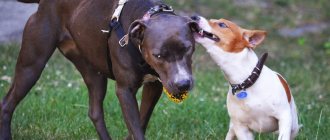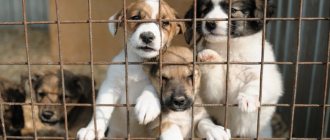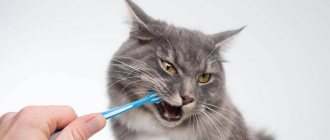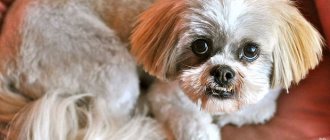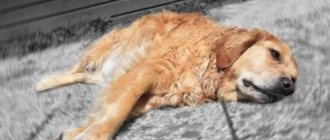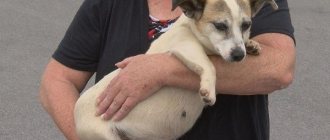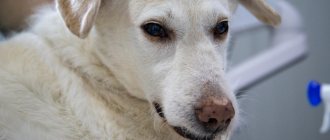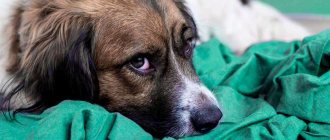Rickets in dogs is a disease of individuals under one year of age, regardless of breed, which is characterized by impaired bone formation and skeletal deformation. It can also occur in adult dogs, but is extremely rare. As a rule, there will be talk about osteomalacia. All this is a consequence of metabolic disorders due to a lack of vitamin D (this includes ergocalciferol D2 - cholecalciferol - D3, etc.).
If you think that you can just start feeding your dog more vitamins and all your problems will be solved, then you are mistaken. This vitamin is not so simple, and the cause of the disease may lie deeper than it seems. Vitamin D itself in its pure form has no effect on the development of rickets. Now let's figure it all out.
Description of the disease
The elements that are responsible for healthy bone development are calcium and phosphorus, the absorption of which is carried out under the influence of the active form of vitamin D2 and D3. Thus, rickets develops when the metabolism of calcium and phosphorus is disturbed. These elements must be supplied with food in the required quantities.
A deficiency or excess of one of these substances is detrimental to the body. Normally, the ratio between calcium and phosphorus should be from 1.5:1 to 2:1, respectively.
Vitamin D is fat soluble, meaning it will not be absorbed without sufficient fat in the diet. Vitamins of group D are activated only under the influence of ultraviolet rays: sunlight or artificial UV radiation. Form D2 is formed under the influence of radiation in products of plant origin and enters the dog’s body with food. And D3 is synthesized under the influence of ultraviolet rays directly in the body.
It is the D3 form that is most actively involved in the absorption of the amount of calcium needed by the body, and therefore fights rickets.
Reasons for the development of pathology in animals
The main cause of rickets is a violation of the supply of vitamin D (ergocalciferol) to the dog’s body, or a failure occurs in the metabolic process. If there is a lack of vitamins, phosphorus and calcium are not absorbed and cannot penetrate into the bone tissue in the required quantities. In young animals, bone growth slows down; in adults, they become fragile.
There may be several reasons why ergocalciferol dysfunction occurs:
- Hormonal problems, namely malfunction of the parathyroid gland. Lack of minerals stimulates increased hormone production. Their action is aimed at washing out certain elements from the bones to replenish the balance of the body.
- Parasitoses. Helminths and protozoa have a detrimental effect on the functioning of the intestines, as a result of which the absorption of minerals from the food eaten is disrupted.
- Poorly formulated diet. Lack of calcium, lack or excess of phosphorus.
- Improper maintenance in a room with high humidity and low light contributes to a slowdown in metabolism.
- Absorption disorders of calcium, phosphorus, vitamin D (with chronic inflammation of the stomach and intestines, liver diseases, viral infections).
- Imbalance of minerals in old pets (osteoporosis), when elements are washed out of the bone skeleton.
Causes of rickets
Insufficient intake of provitamins D (vitamin precursors from which active forms are formed) from food. Because of this, the necessary micro- and macroelements are not absorbed.
Lack, excess or incorrect ratio of calcium and phosphorus in the diet.
Lack of sunlight. If the dog is constantly in a closed enclosure, or is kept exclusively in an apartment.
Excessive or insufficient amounts of fats, proteins, carbohydrates, vitamins and microelements (iron, copper, iodine, etc.) supplied with food. A disruption in the supply of these components entails a failure in the entire metabolism. And for a growing puppy’s body, this is a threat to bone formation - rickets.
If a puppy gets an infectious disease, such as plague, or any inflammatory process in the body, from bronchitis to enteritis, also entails metabolic disorders. And, as a result, rickets develops.
Newborn puppies mainly receive the necessary elements from colostrum and mother's milk. If you are feeding your newborn puppy with artificial milk replacers, you should make sure that they contain D3 and other necessary elements. Artificial cultivation is a common cause of the development of rickets.
Why does it appear
Bone, as the main part of the skeleton, has a complex chemical structure, which includes both organic and inorganic components. The latter include primarily calcium, magnesium and phosphorus. In order for bone tissue to form correctly, it is not enough for the mentioned minerals to enter the body. It is equally important that they are in the correct proportion with each other and, in addition, the necessary conditions for their assimilation are created. The main regulator of calcium-phosphorus metabolism in the body is vitamin D, which ensures the absorption of calcium, magnesium and phosphorus into the blood and their subsequent deposition in the bones.
Important! The optimal ratio of calcium to phosphorus in a puppy's body should be approximately 1.2:1. An excess of calcium is no less dangerous for a growing animal than a deficiency, because in the process of evolution, dogs, mainly living in conditions of calcium deficiency, did not acquire the ability to deal with the reverse imbalance.
Depending on the deficiency of which particular component of calcium-phosphorus metabolism is responsible for the development of the pathology, three main types of rickets are distinguished:
- calciumpenic (calcium deficiency);
- phosphopenic (phosphorus deficiency);
- vitamin D-dependent (vitamin D deficiency with normal calcium and phosphorus levels).
Lack or excess of vitamins
Scientists have calculated how much calcium, phosphorus and vitamin D a dog should normally receive. These indicators are calculated per 1 kg of animal body weight and are:
| Component | Daily value for a puppy, mg per 1 kg of weight | Daily value for an adult, mg per 1 kg of weight |
| Calcium | 320–529 | 120–265 |
| Phosphorus | 266–440 | 100–220 |
| Vitamin D | 10 | 20 |
Despite the fact that the direct cause of rickets is a lack or excess of one of the three mentioned components, this complex pathology can also develop against the background of more complex metabolic disorders in the body, which, in turn, sometimes arise as a result of improper or unbalanced nutrition, in in particular, excess fat, lack of proteins, iron, copper and other trace elements, deficiency of B vitamins, especially thiamine, riboflavin and pyridoxine.
Important! Failure to maintain the balance of nutrients in the diet of a pregnant dog is a much more likely cause of the development of rickets in puppies than improper feeding of the babies themselves during the first year of life.
Factors that lead to a lack of important nutrients in the embryonic stage also include:
- too many puppies in the litter;
- various pathologies of pregnancy;
- allowing a bitch that has not reached full sexual maturity to mate;
- a short period between pregnancies, when the mother’s body does not have time to fully recover;
- premature birth;
- rare exposure of the mother to the sun (lack of vitamin D production in the skin);
- the dog's sedentary lifestyle during pregnancy accompanied by increased feeding, which leads to the birth of overweight puppies;
- poor ecology in the region (high smoke levels in the atmospheric air also impede the synthesis of cholecalciferol).
Another common reason for the development of rickets in puppies is improper artificial feeding. If for some reason a whelping dog does not have enough milk of its own, the cubs have to be supplemented by the owner. For this purpose, you should never use cow's or goat's milk, since such products contain at least 6 times the permissible level of calcium and phosphorus.
By the way, baby food is also not suitable for these purposes, but for a different reason - it contains too much sugar (6.5–7% versus the required 3.1%). Therefore, the best option is to purchase a ready-made mixture from the “artificial bitch’s milk” line in specialized stores. Many manufacturers of premium and super-premium animal feed (Royal Canin, Canina, Beaphar, Nutri-Vet, Hartz, etc.) produce this kind of supplement.
Did you know? As soon as ready-made milk formulas for artificial feeding appeared in a wide assortment on store shelves, the global problem of rickets in infants was solved. It turns out that the main cause of this disease was the use of cow's milk as a substitute for mother's milk.
Infectious diseases
Some diseases, including infectious ones, which either the baby himself or his mother suffered from during pregnancy, can also contribute to the development of rickets in puppies. This group primarily includes:
- acute respiratory viral infections;
- bacterial, viral or fungal infections of the intestines;
- skin diseases that impede the production of cholecalciferol (vitamin D);
- malabsorption, or syndrome of impaired digestion and absorption, is a pathological condition in which certain nutrients cannot be absorbed by the small intestine, as a result, metabolic processes are disrupted, including calcium-phosphorus metabolism;
- diseases of the gastrointestinal tract due to increased acidity of gastric juice;
- many gynecological pathologies or complications of pregnancy (so-called extragenital diseases);
- pathologies of the liver and kidneys of any nature.
The last item on the list requires a separate explanation. The fact is that vitamin D itself is useless in the body. This substance acquires the ability to influence certain metabolic processes only after it has gone through a whole cycle of biochemical transformations, and these transformations occur precisely in the liver and kidneys. The substances that appear as a result are usually called active metabolites of vitamin D. These are calciferol (25-hydroxyvitamin D, or 25(OH)D) and calcitriol (1,25-dihydroxyvitamin D, or 1,25(OH)2D).
Disturbances in calcium-phosphorus metabolism may also be caused not so much by the disease itself as by taking certain medications used to treat it. The greatest danger in this regard are:
- anticonvulsants;
- glucocorticoids;
- antibiotics (especially tetracycline group);
- heparin;
- some hormonal agents (for example, thyroid hormones);
- antacids (drugs that neutralize hydrochloric acid in gastric juice).
Did you know? The English physician Edward Mellanby (1884–1955) is considered the discoverer of vitamin D. During experiments on dogs, the scientist discovered that cod oil is a natural cure for rickets, although at first Mellanby mistakenly attributed the anti-rachitic properties to vitamin A, already known at that time.
Which dogs are at risk?
Since rickets in general cannot be characterized as a hereditary pathology, the risk group includes any dog, regardless of breed size. However, some researchers note that rickets is most severely diagnosed in puppies of large and heavy breeds, in particular:
- Great Danes;
- Mastino Neapolitan;
- German, Caucasian, Central Asian and East European shepherd dogs;
- St. Bernards;
- Irish wolfhounds, etc.
The second category of animals included in the risk group are breeds in which, during the selection process, non-standard skeletal shapes were deliberately formed, in particular, shortened or crooked limbs. The first thing to remember here is:
- bulldogs;
- bull terriers;
- dachshund;
- basset hounds;
- Rottweilers;
- Shar Pei.
Finally, the third type of breeds susceptible to rickets are dogs with thin legs and an overly graceful constitution, for example:
- chihuahua;
- Toy Terrier;
- Italian Greyhound;
- African, Hort and other types of greyhounds.
And yet you need to understand that rickets is a universal pathology. The breeds listed above are at risk not because they suffer from rickets more often than others, but because it is not fatal, in general, the disease affects the general health of such an animal much more strongly, causes it more suffering and inconvenience, and affects the appearance much more bright.
Symptoms of rickets
In the initial stage:
- The puppy seems “lethargic”, but the general condition can be described as satisfactory.
- The quality of the coat deteriorates, the skin is dry and less elastic.
- Appetite decreases or a perversion of appetite develops, with the puppy licking or even trying to eat inedible objects. This can sometimes be seen as puppies licking each other, so you may think it's cute, but it may be a warning sign and you should keep a close eye on your puppies.
- Constipation or diarrhea may indicate a metabolic disorder.
- Tense gait, rapid and frequent stepping from paw to paw.
- Fractures, and spontaneous ones.
- Lameness.
In severe stages:
- The puppy behaves apathetically, tries to lie down as long as possible and not get up.
- The wool is matte, very poor quality. The skin is dry and inelastic.
- A child with rickets is noticeably behind in growth compared to his peers of the same age.
- Appetite is sharply reduced or distorted. It manifests itself more strongly than in the initial stage, in this case the dog can eat soil, rags, paper, and coprophilia develops (when the dog eats feces).
- Due to the symptoms described above and metabolic disorders, gastritis and other problems with the gastrointestinal tract develop.
- Diarrhea alternates with constipation.
- Due to softening of the bones, deformations are observed. The spine sags under the weight of the muscles. It turns out that the spine is curved downward, this is called lordosis. The limbs, usually clearly marked on the front legs, bend inward or outward, thus taking the shape of the letter “O” or “X”. The costal processes become soft. You can feel the so-called “rosary” on the dog’s ribs. The last caudal vertebrae may be resorbed.
- Teeth may fall out.
- The dog is rapidly losing weight, and the body is exhausted.
Danger, complications and consequences of rickets in puppies
The consequences of rickets in dogs can only be avoided at an early stage. Thanks to timely treatment, crooked paws and incorrect posture can be effectively corrected, as well as weakened muscles can be strengthened.
With a later diagnosis, the sick animal will face the following complications:
- convulsions and tremors after long walks;
- pain in the limbs when jumping and running;
- constant shortness of breath and painful breathing due to seals on the ribs;
- visually noticeable deformation of the chest and hip joint;
- various complications during pregnancy and childbirth;
- lack of teeth or severe malocclusion;
- concomitant pathologies of the heart, liver and kidneys.
To avoid death or disability of the dog, it should be shown to a veterinarian immediately after the first alarming symptoms are detected. The earlier treatment is started, the greater the likelihood of a positive prognosis.
Treatment
In puppies, if you start treatment on time, you can achieve one hundred percent success!
Diagnostics
An external examination is not enough to make a diagnosis, although it already says a lot. A competent doctor collects information about the puppy’s care—analyzes the dog’s diet and exposure to sunlight or the presence of artificial ultraviolet radiation.
It is necessary to conduct laboratory blood tests. With vitamin D deficiency in the blood, the following is found:
- lack of calcium and phosphorus;
- increased activity of the enzyme Alkaline Phosphatase (ALP);
- reserve alkalinity changes;
- increased acidity in the blood (ph);
- with an exacerbation of the inflammatory process, an increase in leukocytes is detected in the blood, namely neutrophils - neutrophilic leukocytosis;
- hypochromic anemia (lack of chromium) may occur;
An x-ray will also need to be taken.
First aid
The first thing you should do for your pet is to go to a veterinarian who will confirm the diagnosis of rickets and prescribe you the necessary medications. Do not self-medicate.
Drugs
Treatment must be comprehensive. It is necessary to adjust feeding, living conditions and introduce vitamin and mineral supplements. The use of the following drugs is recommended:
- Ergocalciferol (the dosage and regimen of this drug is prescribed individually, depending on the stage and type of disease).
- Tetravit, retinol, and others.
- Mineral supplements: calcium gluconate, bone and meat and bone meal, fish oil (25 - 30 ml), tricalcium phosphate and others.
- Calcium supplements, such as Brevex.
If left untreated, the disease will definitely not go away on its own, and the dog will eventually become disabled. Skeletal deformation will eventually begin to interfere with the normal functioning of the circulatory, respiratory and other internal systems of the body, which invariably leads to death.
How is rickets treated in puppies and adult dogs?
If during the diagnosis, in addition to rickets, an infection or inflammation was identified, then drug therapy is used to eliminate them. Most often it involves taking the following medications:
- antibiotics that fight bacteria;
- antiviral, destroying viruses;
- glucocorticosteroids that suppress the inflammatory process;
- anticonvulsants, stopping muscle cramps;
- probiotics that normalize intestinal microflora after antibiotics.
In the absence of concomitant diseases, treatment is based on adjusting the existing diet and increasing the amount of natural and artificial ultraviolet radiation. Depending on the severity of the disease, the animal is treated directly at home or in a hospital:
- Advanced stage.
The puppy is given intravenous vitamin drips and physiotherapeutic procedures with a quartz lamp are prescribed. In cases of cardiac dysfunction and acute digestive disorders, preparations with magnesium, enveloping and enzymatic agents are used.
- Initial stage.
In the absence of dangerous complications or immediately after normalization of the condition in the hospital, home treatment begins. It includes a mandatory diet, regular therapeutic massage, careful training to normalize physical activity and mandatory sunbathing in the morning.
If the lack of vitamin D is due to a poor diet, then to normalize it, fermented milk products, egg yolks, beef liver and sea fish are added to the daily menu. Based on the identified deficiencies, the sick four-legged animal is also prescribed a course of various vitamin and mineral complexes.
Nutrition and care
Plays a key role in the dog's recovery. The puppy should be kept in a bright and dry room. He just needs long walks in the fresh air and always under the sun. If this is not possible, artificial UV irradiation procedures using quartz lamps should be prescribed.
The feed should be easily digestible and contain the required amount of calcium and phosphorus. D3 must be present in the diet.
If you feed your dog “natural” food, you must introduce the following products:
- calcined cottage cheese;
- fresh meat;
- vegetables, especially carrots;
- eggs;
- chalk.
If you stick to commercial food, you may need to change the food, which has a composition of vitamins and minerals that is more suitable for removing the body from a pathological condition.
Risk group
Any dog can get sick, regardless of breed. Mostly puppies get sick, but there are cases when rickets affects adults, in which case everything is more complicated.
At risk:
- Large breed dog puppies. The fact is that babies of large breeds grow very quickly, and bone tissue does not have time to develop. Therefore, their nutrition needs to be monitored especially carefully and vitamin-mineral complexes introduced.
- Dogs kept in unfavorable conditions or in dark enclosures without walking are certainly susceptible to hypovitaminosis, and as a result, rickets.
- Puppies born from a mother who did not receive sufficient balanced nutrition during pregnancy.
- Puppies fed on low-quality milk replacers.
- Individuals who have recovered from infectious diseases (plague) or other diseases that have adversely affected their metabolism.
- If the dog does not receive a balanced diet, he is definitely at risk.
Prevention
- The basis of prevention is timely visits to the veterinarian and vaccination.
- Monitor the development of your little pet.
- Balanced feeding. When feeding a dog natural food, vitamin and mineral supplements are necessary. And dry food must be premium and super-premium, in other words, with a guarantee of quality. And make sure that the composition contains D3 or cholecalciferol (the name of this vitamin), as well as a sufficient amount of calcium and phosphorus in the correct 2:1 ratio.
- Sufficient access to sunlight, active walks.
List of drugs
In the treatment of rickets, the following groups of drugs are used:
- Vitamin.
- Ergocalciferol (D)
- Trivitamin (ADE).
- Tetravit (ADEF).
- Milgamma. Multivitamin preparation with analgesic effect.
- Mineral:
- Calcium borogluconate.
- Cyanophore. Source of phosphorus.
- General stimulating:
- Katozal.
- Gamavit.
- Chondroprotectors. Substances that promote cartilage restoration:
- Arthroglycan.
- Stride plus.
- Nutritional supplements:
- Beaphar Salvical.
- Tricalcium phosphate.
Milgamma
FAQ
What can you do to make dogs' paws straighter?
Contact your veterinarian to confirm and identify the stage of rickets. Adjust nutrition, introduce vitamin and mineral supplements. Spend more time with your dog in the sun.
What vitamins for dogs against rickets?
Vitamins D are needed - cholecalciferol and ergocalciferol. And also, products and supplements containing calcium and phosphorus. For example, drugs Brevex, trivitamin, retinol, fish oil, etc.
What is the life expectancy of dogs with rickets?
If the puppy is treated on time, he will fully recover and his lifespan will not differ in any way from dogs that have never suffered from rickets. If an adult dog is sick, it is unlikely that it will fully recover after treatment. But with proper care, it will live its full, long life.
But if you do not take any action to cure your pet, then very soon he will become disabled. Over the course of a year, the skeleton will change beyond recognition and eventually the internal organs will be affected. Without care, such a puppy will not live to see adulthood.
What to do at home
If a puppy is diagnosed with rickets, it is equally important for the owner to avoid two extremes - to pamper the dog in every possible way, not allowing him to move, so as not to increase the curvature of the bones, or, on the contrary, to “drive” him too intensely in order to strengthen the muscles.
It is important to use the right professional food, give the dog adequate physical activity, do not forget about the need for ultraviolet radiation for health, but do not keep the animal under the scorching rays of the sun - this can cause burns and even sunstroke.
If there are many puppies and the weak ones are abused, the owner will have to feed the baby separately so that he gets a full portion and grows strong and strong.
Briefly about the main thing
- Rickets is a disease, mainly in puppies, caused by metabolic disorders and manifested by skeletal deformation.
- The cause of this disease may be: lack of vitamin D, incorrect ratio of calcium and phosphorus in the diet, infection with infectious diseases.
- The main symptoms of rickets: lameness, decreased motor activity, growth retardation, skeletal deformation, especially of the limbs.
- For treatment it is necessary to: adjust nutrition, add vitamins and minerals to the diet. Increase access to sunlight or organize training with artificial ultraviolet light, for example, using quartz lamps.
- At risk are large breed puppies, as well as dogs that do not receive a balanced diet and are kept in unfavorable conditions.
Possible complications
The most serious thing that threatens a sick animal is pathological fractures due to severe curvature of the bones and “washing out” of calcium from them. In addition, the deformed skeleton is not able to support the normal functioning of the dog, and it will have problems with mobility and difficulties in socialization. Crooked, damaged limbs will not allow the dog to lead a normal active lifestyle.
If the disease is advanced, the animal may become disabled. Rickets can lead to disruption of the functioning of internal organs, especially the cardiovascular system.

